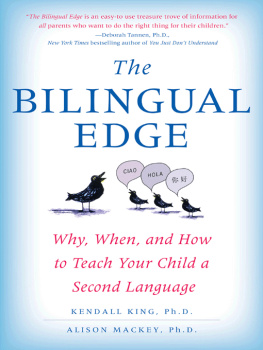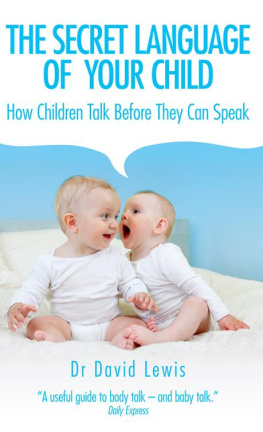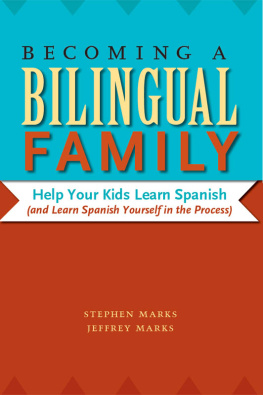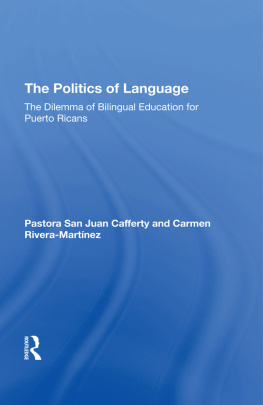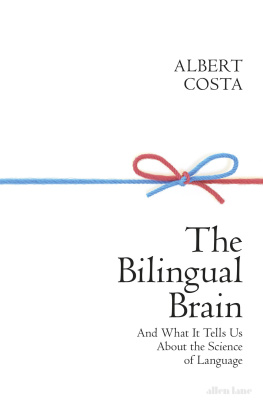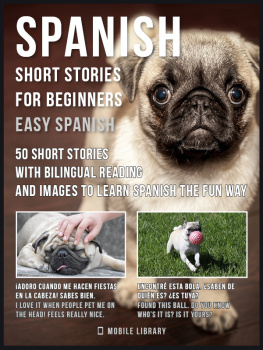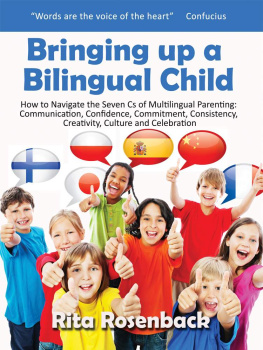KENDALL KING, PH.D.
ALISON MACKEY, PH.D.
A ll babies are born into this world with a gift for language learning. Because of this gift, millions of young children from all around the world routinely become bilingual, and so can yours. No matter what your own language background and situation is, your child deservesand can benefit fromall of the advantages that come with knowing more than one language. This is a special gift that you can begin to give your child from day one.
Knowing more than one language is more important today than ever before. Whether its English, Spanish, French, Korean, or one of the other six thousand languages of the world, parents are increasingly drawn to the lifelong academic, social, cultural, and intellectual advantages that come with learning an additional language. Millions of dollars are spent each year on classes and programs, as well as CDs, DVDs, software programs, educational bilingual toys, and the like, all of which promise to help your child become bilingual. Yet many of these promises end in disappointmentin part because these products and programs are unfortunately not based on what science tells us about how children actually learn languages.
HOW CAN READING THIS BOOK BENEFIT YOUR CHILDREN?
The edge or advantage that comes with bilingualism is a valuable resource for everyone. This edge is evident not only through tests of intelligence and academic ability, but also in childrens enhanced creativity, self-esteem, cross-cultural understanding, and future job opportunities, among other things. Youll finish this book with the knowledge, skills, and confidence you need to provide your children with this bilingual edgean edge we know parents want for their children now more than ever before!
WHO IS THIS BOOK FOR?
The Bilingual Edge is for all parents who would like their children to know more than one language. This includes parents who only speak English, but want to introduce a foreign language effectively and efficiently to their child. This book is for parents who think learning a second language is generally a good idea, but arent sure when to begin or which second language to choose. Its also for parents who have begun to teach their children second languages and would like to know more about whats in store for them. And it is for parents who speak a language like Spanish, Korean, or Russian and want to make sure their children are fluent bilinguals in that language and English.
The Bilingual Edge shows parents from all sorts of language backgroundswith all sorts of childrenhow to assess and leverage their own families situations for optimal child language learning. Every family, and every community, has their own unique strengths that can help in learning a second language. In the following pages, youll discover that you dont necessarily need to fluently speak the language you want your children to learnnor do you need to purchase an extensive (and expensive) foreign language DVD library or enroll your children in fancy, overpriced private schools. What you do need is a bit of knowledge about how language learning happens, and how to put this knowledge to work in your own family.
We guide you through the many questions that parents face. We provide insights from the latest research, which will help you make the best choices for your children concerning which language(s) to choose, when to introduce them, how best to do so, and much more. We present the latest exciting findings about second language learning, from the fields of linguistics, education, and psychology in ways that will matter and be accessible to your family. Every step of the way, key research on language learning is put into context and made relevant for you with real-life examples, activities, quick tips, and checklists, all of which clearly illustrate how you can introduce second languages to your children effectively in easy, fun, and interactive ways. Our aim is to provide scientific, reliable, research-based information and tools that can help you make the best choices for your children concerning their second language learning.
WHO ARE WE AND WHY IS THIS BOOK NEEDED?
We are professors of linguistics at Georgetown University in Washington, D.C. Kendalls area is bilingualism and Alison is an expert in second language learning. Weve been colleagues and friends for more than a decade, independently writing academic articles and books for other researchers about how people learn and use languages. Then one year we had childrena boy and a girl, just two months apart. As we crossed into a new world of parenting (full of playgroups, parenting Web sites, books, and magazines), we realized how badly a book like The Bilingual Edge was needed. In particular, we noticed three things: first, the overwhelming enthusiasm and desire among many, many parents to promote early second language learning; second, widespread misunderstandings about how second languages are learned (and how they arent); and third, a remarkable lack of unbiased, scientifically basedbut understandableinformation out there for parents. Time and again, we hear from parents wondering how to incorporate more than one language into their childs life. Often from experience, parents know that suffering through two years of high school French or Spanish doesnt cut it, but they dont know what the best alternatives are.
We resolved to put our heads together to write a book that helps parents put the latest research into practice with their own children. As parents trying to bring up children who speak more than one language ourselves, we want to share with you what weve learned personally and through our many years of academic experience researching second language learning (weve written almost a hundred books and articles between us, and read many more!). Aside from lots of tools and how-to information in the chapters that follow, youll find facts and insights that strengthen your rationale and your personal resolve to bring your child up knowing more than one language. Our goal is to help our childrenand yoursbecome fluent bilingual speakers. Starting second language learning now will give your child the best chance of becoming fluent and developing a nativelike accent.
The Bilingual Edge provides everything you need to help your child make the most of each and every opportunity for language learning and to reap all the benefits that come with bilingualism. So, lets roll up our sleeves and get started!
Y ou probably already have the idea that youd like to raise your child to speak more than one language. You might have begun already. And youre not alone! Many parents feeland as parents and scientists we wholeheartedly agreethat being bilingual provides an undeniable advantage in life. For children, advanced knowledge of two languages has been shown to result in specific brain benefits, like enhanced creativity and flexibility, increased test scores, and improved literacy skills, as well as social advantages such as greater cross-cultural understanding, adaptability, and increased competitiveness on the job market down the line. Language is interwoven with who we are and how we relate to others, and many parents realize that knowing two or more languages can enhance not only their childrens self-esteem and identity, but also their pride in their own heritage.
Most parents reading this book have a sense of these important advantages (which is why you picked up this book to begin with!). In this chapter, well review some of the most important research findings that demonstrate exactly what these bilingual advantages are. Keeping these scientific findings in mind will help you persevere in the months and years ahead. This research will also arm you with the information you will need to help motivate others and even get any skeptics on your side (including those in your own family, day-care providers, doctors, and teachers who dont know the research).

